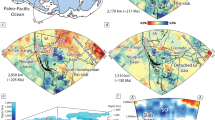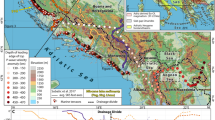Abstract
As the fragments of Gondwana (Africa, Arabia, India and Australia) moved northward, arc-shaped belts with intervening basins formed in the Alpine–Himalayan mountain chain during and after collision. This was accompanied by subduction (or sinking) of the ancient Tethyan oceanic plate (or slab) into the underlying mantle. The arc-like shapes could in part be the end result of processes related to drips forming in the less-viscous mantle layer at the base of the Earth’s rigid outer shell and then falling into the deeper mantle. Alternatively, the arcs could have formed because slabs constituted of intervening small ocean basins were independently subducted during convergence, and have now disappeared. The subducting slabs tend to stretch, tear and eventually break off, leaving behind thin, vertical strips of colder material that can easily be mistaken for mantle drips. Previous work indicates the presence of such remnant material beneath the Hindu Kush region, close to the collision zone between the Indian and Eurasian continental plates. Here, we analyse a cluster of intermediate-depth earthquakes beneath this region and suggest the existence of an elongate boudin, a lens-shaped feature bounded by ductile faults or shear zones. Our data do not support mantle drip and instead offer a snapshot into the process of break-off, as a thin strip of vertically stretching slab tears free before descending deeper into the underlying mantle.
This is a preview of subscription content, access via your institution
Access options
Subscribe to this journal
Receive 12 print issues and online access
$259.00 per year
only $21.58 per issue
Buy this article
- Purchase on Springer Link
- Instant access to full article PDF
Prices may be subject to local taxes which are calculated during checkout






Similar content being viewed by others
References
Channell, J. E. T. & Kozur, H. W. How many oceans? Meliata, Vardar and Pindos oceans in Mesozoic Alpine paleogeography. Geology 25, 183–186 (1997).
Robertson, A. H. F. Contrasting modes of ophiolite emplacement in the Eastern Mediterranean region. Geol. Soc. Lond. Mem. 32, 235–261 (2006).
Kovács, I. & Szabó, Cs. Middle Miocene volcanism in the vicinity of the Middle Hungarian zone: evidence for an inherited enriched mantle source. J. Geodyn. 45, 1–17 (2008).
Rosenbaum, G. & Lister, G. S. The Western Alps from the Jurassic to Oligocene: spatio-temporal constraints and evolutionary reconstructions. Earth-Sci. Rev. 69, 281–306 (2005).
Desmurs, L., Manatschal, G. & Bernoulli, D. The Steinmann Trinity revisited: Mantle exhumation and magmatism along an ocean-continent transition: The Platta nappe, eastern Switzerland. Geol. Soc. Lond. Special Publ. 187, 235–266 (2001).
Weinberg, R. F., Regenauer-Lieb, K. & Rosenbaum, G. Mantle detachment faults and the breakup of cold continental lithosphere. Geology 35, 1035–1038 (2007).
Lister, G. S., Forster, M. A. & Rawling, T. J. Episodicity during orogenesis. Geol. Soc. Lond. Special Publ. 184, 89–113 (2001).
Forster, M. A. & Lister, G. S. Several distinct tectonometamorphic slices in the Cycladic eclogite-blueschist belt, Greece. Contrib. Mineral. Petrol. 150, 523–545 (2005).
Carminati, E., Wortel, M. J. R., Spakman, W. & Sabadini, R. The role of slab detachment processes in the opening of the western–central Mediterranean basins: some geological and geophysical evidence. Earth Planet. Sci. Lett. 160, 651–665 (1998).
Schellart, W. & Lister, G. S. Tectonic models for the formation of arc-shaped convergent zones and back-arc basins. Geol. Soc. Am. Special Paper 383, 237–258 (2004).
Rosenbaum, G. & Lister, G. S. Formation of arcuate orogenic belts in the western Mediterranean region. Geol. Soc. Am. Special Paper 383, 41–56 (2004).
Gutscher, M.-A. et al. Evidence for active subduction beneath Gibraltar. Geology 30, 1071–1074 (2002).
Wortel, M. J. R. & Spakman, W. Subduction and slab detachment in the Mediterranean–Carpathian region. Science 290, 1910–1917 (2000).
Houseman, G. A. & Molnar, P. Gravitational (Rayleigh–Taylor) instability of a layer with non-linear viscosity and convective thinning of continental lithosphere. Geophys. J. Int. 128, 125–150 (1997).
Kerr, R. A. Making mountains with lithospheric drips. Science 239, 978–979 (1988).
Houseman, G. A. & Molnar, P. Mechanisms of lithospheric rejuvenation associated with continental orogeny. Continental reactivation and reworking. Geol. Soc. Lond. Special Publ. 184, 13–38 (2001).
Platt, J. & Houseman, G. Evidence for active subduction beneath Gibraltar: Comment and Reply. Geology 31, 22 (2003).
Platt, J. P., Whitehouse, M. J., Kelley, S. P., Carter, A. & Hollick, L. Simultaneous extensional exhumation across the Alboran Basin: Implications for the causes of late orogenic extension. Geology 31, 251–254 (2003).
Platt, J. P. & Vissers, R. Extensional collapse of thickened continental lithosphere: A working hypothesis for the Alboran Sea and Gibraltar arc. Geology 17, 540–543 (1989).
Zandt, G. et al. Active foundering of a continental arc root beneath the southern Sierra Nevada in California. Nature 431, 41–46 (2004).
Royden, L. H. Evolution of retreating subduction boundaries formed during continental collision. Tectonics 12, 629–638 (1993).
Lonergan, L. & White, N. Origin of the Betic-Rif mountain belt. Tectonics 16, 504–522 (1997).
Rosenbaum, G., Lister, G. S. & Duboz, C. Reconstruction of the tectonic evolution of the western Mediterranean since the Oligocene. J. Virtual Explorer 8, 107–130 (2002).
Richards, S., Lister, G. S. & Kennett, B. L. N. A slab in depth: Three-dimensional geometry and evolution of the Indo-Australian plate. Geochem. Geophys. Geosyst. 8doi:10.1029/2007GC001657 (2007).
Chouhan, R. K. S. Seismotectonics of Hindukush. Pure Appl. Geophys. 82, 108–118 (1970).
Ram, A. & Yadav, L. Seismotectonics and analysis of earthquakes from the Hindukush region. Geophys. J. R. Astron. Soc. 68, 559–574 (1982).
Roecker, S. W. et al. Seismicity and fault plane solutions of intermediate depth earthquakes in the Pamir-Hindu Kush region. J. Geophys. Res. 85, 1358–1364 (1980).
Roecker, S. W. Velocity structure of the Pamir-Hindu Kush region: Possible evidence of subducted crust. J. Geophys. Res. 87, 945–959 (1982).
Mellors, R. J., Pavlis, G. L., Hamburger, M. W., Al-Shukri, H. J. & Lukk, A. A. Evidence for a high-velocity slab associated with the Hindu Kush seismic zone. J. Geophys. Res. 100, 4067–4078 (1995).
<http://neic.usgs.gov/>.
Koulakov, I. & Sobolev, S. V. A tomographic image of Indian lithosphere break-off beneath the Pamir-Hindukush region. Geophys. J. Int. 164, 425–440 (2006).
Khan, P. K. Stress state, seismicity and subduction geometries of the descending lithosphere below the Hindukush and Pamir. Gondwana Res. 6, 867–877 (2003).
Fan, G., Ni, J. F. & Wallace, T. C. Active tectonics of the Pamirs and Karakoram. J. Geophys. Res. 99, 7131–7160 (1994).
Negredo, A. M., Replumaz, A., Villaseñor, A. & Guillot, S. Modeling the evolution of continental subduction processes in the Pamir–Hindu Kush region. Earth Planet. Sci. Lett. 259, 212–225 (2007).
<http://www.globalcmt.org/>.
Platt, J. P. & Vissers, R. L. M. Extensional structures in anisotropic rocks. J. Struct. Geol. 2, 397–410 (1980).
Lacassin, R. Large-scale foliation boudinage in gneisses. J. Struct. Geol. 10, 643–647 (1988).
Goscombe, B. D., Passchier, C. W. & Hand, M. Boudinage classification: End-member boudin types and modified boudin structures. J. Struct. Geol. 26, 739–763 (2004).
Arslan, A., Passchier, C. W. & Koehn, D. Foliation boudinage. J. Struct. Geol. advance online publication doi:10.1016/j.jsg.2007.11.004 (19 November 2007).
Forster, M. A. et al. in Mapping Geology in Italy (eds Pasquaré, G. & Venturini, C.) 279–286 (Servizio Geologico d’Italia, 2004).
Jiao, W., Silver, P. G., Fei, Y. & Prewitt, C. T. Do intermediate- and deep-focus earthquakes occur on preexisting weak zones? An examination of the Tonga subduction zone. J. Geophys. Res. 105, 28125–28138 (2000).
Ranero, C. R., Villaseñor, A., Phipps Morgan, J. & Weinrebe, W. Relationship between bend-faulting at trenches and intermediate-depth seismicity. Geochem. Geophys. Geosyst. 6doi:10.1029/2005GC000997 (2005).
Kawakatsu, H. Double seismic zone in Tonga. Nature 316, 53–55 (1985).
Warren, L. M., Hughes, A. N. & Silver, P. G. Earthquake mechanics and deformation in the Tonga-Kermadec subduction zone from fault plane orientations of intermediate- and deep-focus earthquakes. J. Geophys. Res. 112doi:10.1029/2006JB004677 (2007).
Saleeby, J. & Foster, Z. Topographic response to mantle lithosphere removal in the southern Sierra Nevada region, California. Geology 32, 245–248 (2004).
Kelemen, P. B. & Hirth, G. A periodic shear-heating mechanism for intermediate-depth earthquakes in the mantle. Nature 446, 787–790 (2007).
Regenauer-Lieb, K. & Yuen, D. A. Rapid conversion of elastic energy into plastic shear heating during incipient necking of the lithosphere. Geophys. Res. Lett. 25, 2737–2740 (1998).
Kameyama, M., Yuen, D. A. & Karato, S.-I. Thermal-mechanical effects of low-temperature plasticity (the Peierls mechanism) on the deformation of a viscoelastic shear zone. Earth Planet. Sci. Lett. 168, 159–172 (1999).
Regenauer-Lieb, K. & Yuen, D. A. Quasi-adiabatic instabilities associated with necking processes of an elasto-viscoplastic lithosphere. Phys. Earth Planet. Inter. 118, 89–102 (2000).
Acknowledgements
Research supported by Australian Research Council Discovery Grant DP0343646 ‘Tectonic Reconstruction of the Evolution of the Alpine–Himalayan Orogenic Chain’. A. Barker is thanked for his work on the Vrancea slablet using eQuakes.
Program eQuakes written by GL, who accepts all responsibility for errors of interpretation occasioned by its use.
Author information
Authors and Affiliations
Corresponding author
Rights and permissions
About this article
Cite this article
Lister, G., Kennett, B., Richards, S. et al. Boudinage of a stretching slablet implicated in earthquakes beneath the Hindu Kush. Nature Geosci 1, 196–201 (2008). https://doi.org/10.1038/ngeo132
Received:
Accepted:
Published:
Issue Date:
DOI: https://doi.org/10.1038/ngeo132
This article is cited by
-
Upper mantle melt caused by a subducted slab in the Indian-Eurasian continental subduction zone
Communications Earth & Environment (2023)
-
Seismic Response and Vulnerability Evaluation of Jammu Region (Jammu and Kashmir)
Indian Geotechnical Journal (2023)
-
Application of Microzonation Towards System-Wide Seismic Risk Assessment of Railway Network
Transportation Infrastructure Geotechnology (2023)
-
Liquefaction hazard assessment in a seismically active region of Himalayas using geotechnical and geophysical investigations: a case study of the Jammu Region
Bulletin of Engineering Geology and the Environment (2022)
-
P-wave minimum 1D velocity model for central and northern Pakistan
Journal of Seismology (2022)



